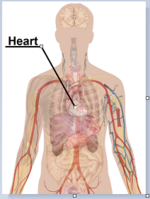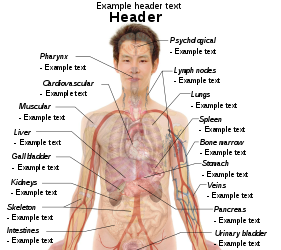Soubor:Surface projections of the organs of the trunk.png

Velikost tohoto náhledu: 374 × 598 pixelů. Jiná rozlišení: 150 × 240 pixelů | 300 × 480 pixelů | 375 × 600 pixelů | 480 × 768 pixelů | 640 × 1 024 pixelů.
Tento soubor pochází z Wikimedia Commons a mohou ho používat ostatní projekty. Níže jsou zobrazeny informace, které obsahuje jeho tamější stránka s popisem souboru.
Obsah
Popis
| PopisSurface projections of the organs of the trunk.png |
English: Surface projections of the major organs of the trunk, using the vertebral column and rib cage as main reference points of superficial anatomy. The transpyloric plane and McBurney's point are among the marked locations.
To discuss image, please see Talk:Human body diagrams |
| Datum | |
| Zdroj |
All included images are in public domain. See Template:Human body diagrams for individual details. ReferencesSpinal vertebrae levels:
Gross overview of organ locations:
Locations of specific organs:
Position of the navel
Urinary tract: |
| Autor | Mikael Häggström |
Licence
| Public domainPublic domainfalsefalse |
| Já, autor tohoto díla, jej tímto uvolňuji jako volné dílo, a to celosvětově. V některých zemích to není podle zákona možné; v takovém případě: Poskytuji komukoli právo užívat toto dílo za libovolným účelem, a to bezpodmínečně s výjimkou podmínek vyžadovaných zákonem. |
Human body diagramsMain article at: Human body diagrams Template location:Template:Human body diagrams How to derive an imageDerive directly from raster image with organsThe raster (.png format) images below have most commonly used organs already included, and text and lines can be added in almost any graphics editor. This is the easiest method, but does not leave any room for customizing what organs are shown. Adding text and lines: Derive "from scratch"By this method, body diagrams can be derived by pasting organs into one of the "plain" body images shown below. This method requires a graphics editor that can handle transparent images, in order to avoid white squares around the organs when pasting onto the body image. Pictures of organs are found on the project's main page. These were originally adapted to fit the male shadow/silhouette.
Organs:
Derive by vector templateThe Vector templates below can be used to derive images with, for example, Inkscape. This is the method with the greatest potential. See Human body diagrams/Inkscape tutorial for a basic description in how to do this.
Examples of derived works
Licensing
|
Popisky
Položky vyobrazené v tomto souboru
zobrazuje
Nějaká hodnota bez položky na Wikidatech
5. 9. 2010
image/png
Historie souboru
Kliknutím na datum a čas se zobrazí tehdejší verze souboru.
| Datum a čas | Náhled | Rozměry | Uživatel | Komentář | |
|---|---|---|---|---|---|
| současná | 27. 12. 2019, 10:19 |  | 1 583 × 2 533 (3,33 MB) | Mikael Häggström | (+Costal margin) |
Využití souboru
Na soubor odkazuje tato stránka:
Metadata
| Rozlišení obrázku na šířku | 118,09 dpc |
|---|---|
| Rozlišení obrázku na výšku | 118,09 dpc |
| Použitý software |
|































